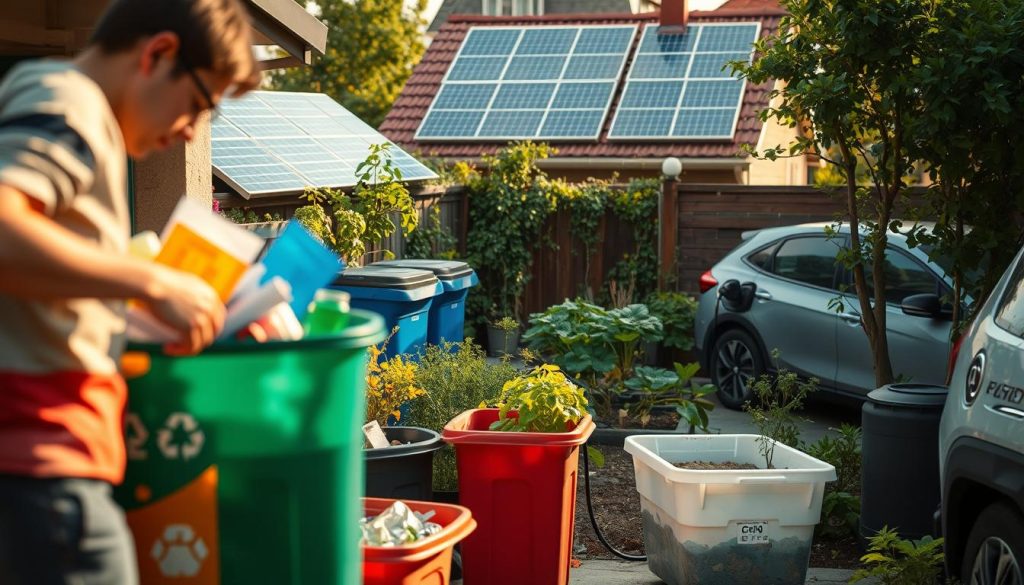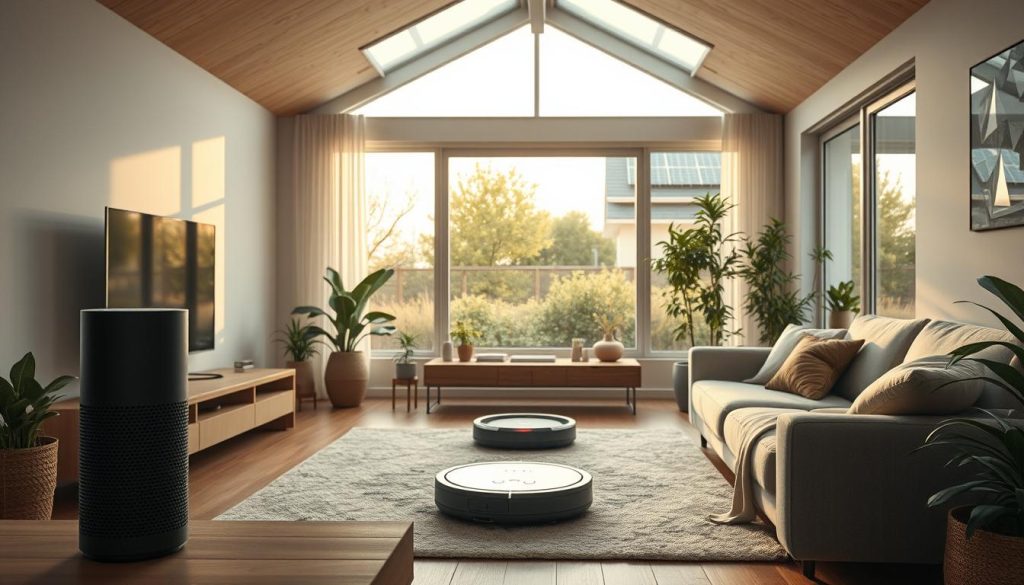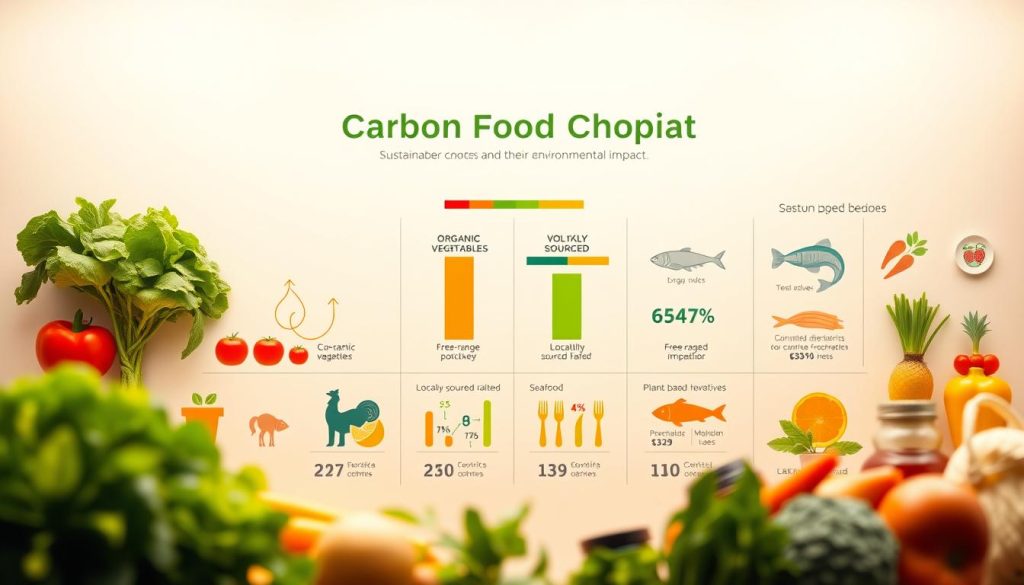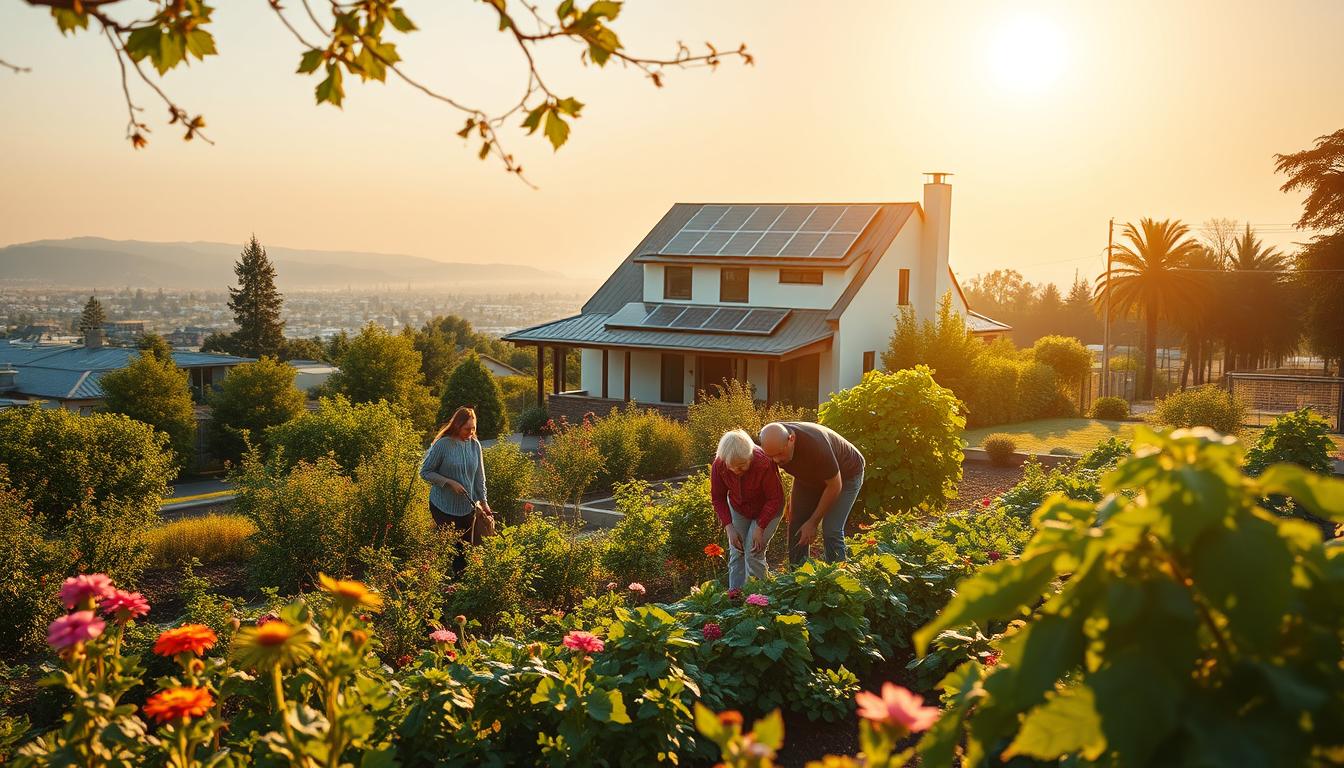Starting a greener lifestyle is easy with simple choices. It’s not about big changes or spending a lot. It’s about making choices that help you and the planet.
Many people wonder if their actions can really help. The truth is, yes, they can. When we all make small choices for the planet, the effects are huge.
In this guide, we’ll show you how to live more sustainably. You’ll learn how to make your home, kitchen, commute, and shopping habits greener. You’ll see that living eco-friendly can save money, improve your health, and give you a sense of purpose.
Changing your ways doesn’t mean you have to be perfect. It’s about making progress. Every step you take helps create positive change. Are you ready to see how small changes can make a big difference? Let’s start.
The Urgent Need for Sustainable Living in Today’s World
Climate change is speeding up in the United States, making sustainable living essential. Our daily choices now impact ecosystems, communities, and future generations. We must take action, not just be aware of the environmental challenges.
The Environmental Crisis We Face
Our planet is showing signs of distress through rising temperatures and extreme weather. These issues are real and affect American communities today.
Climate Change Impacts in the United States
Climate change affects America in different ways. The Southeast deals with destructive hurricanes, while the West faces drought. Coastal cities like Miami and New York worry about rising sea levels.

Climate disruptions are economic and social problems. Hurricanes destroy homes, droughts harm crops, and floods displace people. These issues cause financial and health problems for many Americans.
Resource Depletion and Biodiversity Loss
We’re seeing high rates of resource use. Freshwater is under pressure, and forests are shrinking. This is bad for our climate.
Biodiversity loss affects our food and medicine. Without pollinators, one-third of our food is at risk. This shows how important environmental conservation is.
| Environmental Challenge | U.S. Regions Most Affected | Economic Impact | Sustainable Solutions |
|---|---|---|---|
| Extreme Heat | Southwest, South | $100+ billion annually | Urban green spaces, renewable energy |
| Water Scarcity | West, Southwest | $4.3 billion in agriculture losses | Water conservation, efficient irrigation |
| Sea Level Rise | East Coast, Gulf Coast | $3.6 trillion in property at risk | Coastal restoration, managed retreat |
| Biodiversity Loss | Nationwide | $57 billion in pollination services | Habitat protection, native landscaping |
How Individual Actions Create Collective Impact
It’s easy to feel like our actions don’t matter against such big challenges. But history shows that personal choices can lead to big changes when we all do them.
The Ripple Effect of Personal Choices
Every choice we make has a big impact. By using public transport, we save emissions and support community systems. This makes sustainable living easier for everyone.
Choosing products with less packaging sends a message to companies. It tells them we care about the environment. This drives them to make more sustainable products.
Success Stories of Community-Led Change
Communities across America are showing the power of working together on climate change. Georgetown, Texas, became the first city to run on 100% renewable energy. This was a smart move for the economy and community values.
In Portland, Oregon, people are composting on a neighborhood level. This has reduced waste and brought communities together. In rural Minnesota, farmers are using new methods to improve soil and fight climate change.
These stories show that change can start with individual actions. They prove we don’t always need big policies to make a difference. We can start today.
Essential Sustainable and Eco-Friendly Practices for Daily Life
Sustainable living is about making progress, not being perfect. It’s about making choices that help us now and protect the future. By understanding sustainability, we can make big changes easily.
Defining Sustainability in Everyday Terms
Sustainability means we can meet our needs without harming future generations. In daily life, it’s about reducing waste, saving resources, and helping communities stay healthy.
Think of sustainability as a journey, not a goal. It’s about using reusable bags, saving water, and buying local. These small steps add up to big changes.

It’s about finding a balance between today’s needs and tomorrow’s. For example, buying a good water bottle saves money and the planet in the long run.
In Minnesota, smart thermostats save energy and money. In Arizona, desert landscaping saves water without losing beauty.
The Three Pillars: Environmental, Social, and Economic Sustainability
Sustainability has three main parts. Environmental focuses on nature and resources. Social ensures communities are fair and equal. Economic aims for long-term wealth without harming resources.
These pillars support a circular economy. Products are made to be reused, fixed, or recycled, not thrown away. This reduces waste and makes the most of what we have.
How These Pillars Interact in American Society
In America, these pillars work together in many ways. Community solar projects in Colorado are a great example. They cut carbon emissions, create jobs, and offer affordable energy.
Shopping at farmers’ markets in New England supports local farmers (economic), cuts emissions (environmental), and strengthens community ties (social). These choices show how sustainable living covers all three pillars.
Understanding these basics helps you make better choices. Every decision you make moves us closer to a sustainable future. It’s about progress, not perfection.
Transforming Your Home into an Eco-Friendly Haven
Turning your home into an eco-friendly space is good for the planet. It also makes your home healthier and more efficient, saving you money. The average American home uses a lot of energy, water, and indoor pollutants.
By making smart changes, you can lessen your impact on the environment. You’ll also make your home more comfortable.
Energy-Efficient Upgrades That Pay for Themselves
Energy efficiency is a big win for home sustainability. Many upgrades save you money on utilities, increase your home’s value, and offer tax breaks. The federal government now offers a 30% tax credit for energy-efficient home improvements.
2023 is a great year to make these upgrades.
Smart Thermostats and LED Lighting
Smart thermostats are a key energy-saving tool for homeowners. They learn your habits and adjust the temperature to save energy.
Models like the Nest Learning Thermostat or ecobee SmartThermostat can cut heating and cooling costs by 10-15%. This saves about $145 a year for the average household. Installation is quick, and many utilities offer rebates to help with the cost.

LED lighting is another quick way to save energy. While they cost more upfront, they use 75% less energy and last longer. Switching to LEDs can save your home about $225 a year.
Renewable Energy Options for Homeowners
Renewable energy is getting more affordable for homeowners. Solar panel costs have dropped by over 60% in the last decade.
There are several ways to go solar. Buying a system outright saves the most money over time but requires a big upfront investment. Solar leasing and power purchase agreements (PPAs) offer zero-down options with immediate savings, but the long-term benefits are less.
Community solar programs are another option. They allow you to get credit on your electricity bill for the power produced by a shared solar facility. This makes renewable energy more accessible.
| Solar Option | Upfront Cost | Monthly Savings | Payback Period | Best For |
|---|---|---|---|---|
| Purchase System | $15,000-$25,000 | $100-$200 | 7-10 years | Long-term homeowners with good roof conditions |
| Solar Lease | $0-$1,000 | $20-$50 | Immediate savings | Homeowners wanting simplicity with less maintenance |
| Community Solar | $0-$500 | $10-$30 | Immediate savings | Renters or homes with unsuitable roofs |
| Solar PPA | $0 | $15-$40 | Immediate savings | Budget-conscious homeowners seeking predictable rates |
Water Conservation Strategies for American Households
Water conservation varies by region in America. Western states face drought, while other areas deal with old infrastructure and high water costs. Saving water benefits your wallet and the environment.
Low-Flow Fixtures and Rainwater Harvesting
Low-flow fixtures are a simple way to save water. Modern showerheads use less water without losing pressure. A family of four can save nearly 20,000 gallons a year with one upgrade.
Dual-flush toilets also save water. They use less for liquid waste and more for solid waste. This can save 20-40% of toilet water usage, which is a big part of indoor water use.
Rainwater harvesting captures rainwater for irrigation and indoor use. In wetter regions, a basic 50-gallon barrel can collect over 1,000 gallons a year. More advanced systems can store thousands of gallons underground.
Creating a Non-Toxic Living Environment
The average home has many potential toxins in cleaning products, furniture, and building materials. Creating a non-toxic home reduces exposure to harmful chemicals and supports the environment by reducing chemical production and waste.
Natural Cleaning Alternatives
Many cleaning products contain harmful chemicals. Natural alternatives can be just as effective without these risks.
Ingredients like white vinegar, baking soda, and castile soap can clean your home at a fraction of the cost. For example, a mix of equal parts vinegar and water cleans windows and countertops for pennies.
If you prefer ready-made solutions, brands like Seventh Generation and Method offer effective products with clear ingredient lists and eco-friendly practices. These products are a bit pricier but eliminate harmful chemicals and support environmental stewardship.
Indoor Air Quality Improvements
Indoor air often has more pollutants than outdoor air, according to the EPA. Improving air quality makes your home healthier and reduces energy needs for ventilation and filtration.
Houseplants are natural air purifiers. Species like snake plants and spider plants remove indoor pollutants. Experts recommend one medium-sized plant per 100 square feet for the best air-cleaning benefits.
HVAC filters are key to maintaining air quality. Upgrading to MERV 11-13 filters captures more pollutants than standard filters. In humid areas, consider a whole-house dehumidifier to prevent mold. In dry areas, humidification can reduce respiratory irritation.
Sustainable Food Choices and Their Environmental Impact
What we eat greatly affects our planet. Making sustainable food choices is key to living consciously. The American food system is responsible for about 30% of our carbon footprint, from growing to waste.
By choosing wisely, we can lessen our environmental impact. We also improve our health and support local economies.
The Case for Plant-Based and Locally Sourced Foods
Choosing plant-based meals and local ingredients helps the environment. Plants need fewer resources than animal products. Locally grown foods also cut down on “food miles.”
Local food systems build community and keep traditions alive. Many people enjoy seasonal eating, which is healthier and cheaper. Even a few meatless meals a week can help.
Carbon Footprint Comparison of Different Diets
Different diets have different environmental effects. Animal products often require more resources than plants. But, the exact numbers might surprise you.

| Diet Type | CO₂ Emissions (kg/year) | Water Usage (gallons/day) | Land Use (sq ft/person) | Relative Environmental Impact |
|---|---|---|---|---|
| Standard American | 3,300 | 1,320 | 18,000 | High |
| Flexitarian | 2,100 | 1,020 | 12,000 | Medium |
| Vegetarian | 1,700 | 800 | 8,000 | Medium-Low |
| Vegan | 1,350 | 600 | 4,000 | Low |
Reducing Food Waste in Your Kitchen
Americans waste nearly 40% of their food, costing about $1,500 a year. This waste is not just money but also resources and methane emissions. Methane is a strong greenhouse gas.
Small changes can make a big difference. Plan your shopping and use everything you buy. Store food right to keep it fresh longer.
Meal Planning and Creative Leftover Usage
Good meal planning is key to reducing waste. Check what you have before shopping. Plan meals that use similar ingredients.
Turn yesterday’s veggies into today’s frittata or soup. Use overripe fruits for smoothies or bread. See potential in every food item and plan with purpose.
Sustainable Food Shopping Habits
Our shopping habits greatly affect our food’s environmental impact. Sustainable shopping goes beyond what we buy. It includes how we carry groceries and support businesses.
Use reusable bags and containers to reduce packaging. Buy foods with less packaging and in bulk for staples. Support businesses that care about the environment.
Navigating Farmers Markets and CSA Programs
Farmers markets and CSA programs connect us to local food. They offer foods with less travel and fewer chemicals. You can also learn from growers about sustainable farming.
Visit markets late for discounts. Share a CSA with neighbors or volunteer for produce. Many markets accept SNAP and offer matching programs for fresh, local food.
Understanding Food Labels and Certifications
Food labels and certifications can be confusing. Some have strict standards, while others are vague. Learning to read these labels helps you make eco-friendly choices.
USDA Organic bans synthetic pesticides and GMOs. Rainforest Alliance focuses on biodiversity and worker welfare. Marine Stewardship Council ensures sustainable fishing. Look for certifications with real standards and verification.
Revolutionizing Your Approach to Waste
In our society, changing how we handle waste is key. The average American throws away about 4.9 pounds of trash daily. That’s nearly 1,800 pounds a year. Recycling is a start, but there’s more to do to reduce waste.
We need to go beyond recycling. It’s about changing how we see waste. We should aim for a world where resources are reused, not thrown away.
Beyond Recycling: Embracing the Zero-Waste Movement
The zero-waste movement is a big change. It looks at the whole life of a product, from start to finish. It aims to cut out waste at every step.
Getting to zero waste might seem hard. But it’s about making progress, not being perfect. Cutting your waste by 50% can help the planet and save money.
Practical Steps to Reduce Household Waste
Start by doing a waste audit. For a week, track everything you throw away or recycle. Sort it by type to see where you can cut down.
Once you know your waste patterns, tackle each room:
- Kitchen: Keep food fresh to avoid waste, use cloth towels, and choose reusable containers.
- Bathroom: Use bar soap, solid shampoo, and safety razors. Choose cloth towels over disposable wipes.
- Living areas: Go digital, fix things instead of throwing them away, and borrow or rent what you don’t use often.
- Office: Use digital documents, refillable pens, and reuse single-sided paper for notes.
Composting Solutions for Urban and Suburban Settings
Food scraps and yard waste make up 30% of what we throw away. Composting these items keeps them out of landfills. It turns them into soil that’s good for plants.
Suburban homes can compost in many ways. Backyard bins or piles work for yard waste and most food scraps. For less smell and pests, try enclosed tumblers. Many suburbs also offer composting programs for more types of waste.
Apartment-Friendly Composting Methods
Apartment dwellers can compost too. Vermicomposting systems fit under sinks and handle food waste with little smell. They use worms to break down waste fast.
Bokashi is another option for apartments. It ferments food waste, including meat and dairy, before it’s buried. Community gardens and cities with compost programs are also great options.
Breaking Free from Single-Use Plastics
Single-use plastics are a big problem. They often end up in landfills, waterways, and oceans. But, there are many reusable alternatives.
Reusable Alternatives for Everyday Items
Switching to reusable items cuts waste and can save money. Here’s how some common items compare:
| Single-Use Item | Reusable Alternative | Environmental Impact | Cost Savings (1 Year) |
|---|---|---|---|
| Plastic water bottles | Stainless steel bottle | Prevents ~156 bottles from landfill | $200-300 |
| Coffee cups | Insulated travel mug | Prevents ~250 cups from landfill | $25-75 (plus discounts) |
| Grocery bags | Canvas totes | Prevents ~500 plastic bags | $15-40 |
| Paper towels | Cloth napkins/towels | Saves trees and reduces waste | $50-100 |
| Plastic wrap | Beeswax wraps/containers | Reduces petroleum-based plastic | $30-60 |
Navigating a Plastic-Filled World
Avoiding plastic is hard in today’s world. But, focus on making progress. Bring your own bags and containers when shopping. Choose products in glass, paper, or metal.
For takeout, carry a “zero waste kit” with reusable utensils and a container. Many restaurants now accept reusable containers.
Every small action helps. When we all choose less packaging, businesses will too. Together, we can make a big difference.
Ethical Consumerism: Voting with Your Dollar
Shopping can be a way to show what you value. By choosing products from companies that care about the environment, you’re making a statement. In the U.S., people spend over $13 trillion a year. This money can push companies to change for the better.
More Americans want companies to be green. Yet, many feel it’s hard to choose the right products. A study showed 73% of U.S. consumers think about the environment when they buy things.
Researching Brands and Their Environmental Commitments
Start by figuring out what’s important to you. This could be anything from carbon footprint to animal welfare. Companies often talk about their green efforts on their websites. But, it’s crucial to spot the real deals from the fake ones.
Look for real actions and goals from companies. True eco-friendly companies publish detailed reports and updates. They also have third-party certifications to prove their claims.
Tools and Resources for Conscious Shopping
Shopping ethically doesn’t have to be hard. There are many tools to help you make good choices. These tools rate companies based on ethics, making it easier to shop with your values in mind.
| Resource | Best For | Features | Accessibility |
|---|---|---|---|
| Good On You | Fashion | Rates brands on people, planet, and animals | Free app and website |
| EWG’s Skin Deep | Personal Care | Ingredient safety ratings for 70,000+ products | Free database with barcode scanner |
| Buycott | Groceries | Scans products to check against your values | Free app with customizable campaigns |
| B Corp Directory | All Industries | Lists certified companies meeting high standards | Free searchable database |
The True Cost of Fast Fashion and Alternatives
The fashion world is huge, with a $2.5 trillion global market. Americans now buy five times more clothes than in 1980. But, they wear these clothes for half as long. This fast fashion model is cheap but comes at a big cost.
Fashion is bad for the planet. It’s responsible for 10% of global carbon emissions and 20% of global wastewater. In the U.S., 11.3 million tons of textile waste go to landfills every year. That’s about 80 pounds per person.
But, there’s hope. Sustainable fashion is growing, with options for all budgets. Brands like Patagonia and Eileen Fisher lead the way. They focus on organic materials and fair labor.
Second-hand shopping is also a great option. It’s projected to hit $64 billion in the U.S. by 2024. Sites like ThredUp and Poshmark make it easy to find quality used items.
Investing in Quality Over Quantity
Changing how you shop is key. Instead of buying cheap, trendy items, invest in quality. These items may cost more upfront but last longer and are more enjoyable.
Think about the cost per use. A $20 shirt worn 5 times costs $4 per wear. But, a $100 shirt worn 50 times costs just $2 per wear. The cheaper item is actually more expensive in the long run.
The Long-Term Economics of Buying Less but Better
This idea applies to many areas of your life. A $200 sofa might cost twice as much as a cheaper one. But, it lasts four times as long. Quality items in your home, like kitchen tools and electronics, also save you money in the long run.
Buying fewer, better things saves you money and reduces waste. It also makes your life simpler. Many people find that having fewer possessions leads to more space and happiness.
Sustainable Transportation and Travel Choices
Our daily travel choices make up nearly 30% of our carbon footprint. This makes choosing eco-friendly ways to get around very important. Many places were built for cars, but new options are emerging that are good for the planet and easy to use.
What we do every day and how we travel on vacation can really help the environment. These choices are big chances to lessen our impact on the planet.
Reducing Your Carbon Footprint on the Road
Small changes in how we travel can make a big difference. Doing all your errands in one trip, keeping your tires at the right pressure, and not idling can cut fuel use by up to 15%. Many people find that driving less doesn’t mean giving up convenience.
Public Transit, Carpooling, and Bike Infrastructure
Cities like Portland, Minneapolis, and Washington DC are investing in public transport and bike paths. This makes it easier to not use a car. Apps like Transit and Citymapper help you find the best way to travel, and ride-sharing connects people going the same way.
In suburbs, park-and-ride spots offer a good mix of car and public transport use. E-bikes have also become very popular, with sales up 240% since 2020.
Eco-Friendly Vacation Planning
Travel can be done in a way that’s good for the planet. By choosing the right places and activities, you can enjoy your trips without harming the environment. For short trips, trains are a better choice than flying, as they produce much less carbon.
Sustainable Tourism Practices and Certifications
When you book a place to stay, look for LEED, Green Key, or Green Globe certifications. These places use clean energy and save water. The Global Sustainable Tourism Council helps find true eco-friendly places, not just those that seem green.
The Rise of Electric and Hybrid Vehicles in America
More people are choosing electric cars, with over 40 models available. EV owners save $800-$1,000 a year on fuel and upkeep compared to gas cars. Today’s electric cars can go over 250 miles without needing to charge, easing worries about running out of power.
Charging Infrastructure and Incentives
There are now over 50,000 public charging stations in America, with thousands more being added every month. You can get up to $7,500 off a new electric car through federal tax credits and state incentives. Many electric companies offer special rates for charging at night, using clean energy and saving money.
Building Community Through Sustainable Practices
Turning eco-friendly habits into community action is powerful. When neighbors work together, their efforts grow stronger. This teamwork creates a better future for all.
Starting Local Initiatives in Your Neighborhood
First, find out what your community needs. Maybe recycling is hard or green spaces are scarce. Then, reach out to others through social media or local events.
Start small and watch your efforts grow. A clean-up day can make a big difference. It boosts pride and encourages more action.
Community gardens are a great start. They turn empty lots into places for fresh food. To begin, check local rules, get permission, and gather volunteers.
Sharing programs also help. Tool libraries and seed exchanges save resources and build bonds. Free stores and repair cafés reduce waste and support reuse.
Supporting Environmental Policies and Advocacy
Local decisions affect our planet. Zoning laws and waste systems are key. By getting involved, you can make a difference.
Effective Ways to Engage with Local Government
Go to city council meetings to speak up. Write comments on new plans. Join forces with local groups to strengthen your voice.
Keep pushing for change. Even small wins help pave the way for bigger successes.
Teaching the Next Generation About Sustainability
Teaching kids about the environment is crucial. They will carry on our efforts for years to come.
Age-Appropriate Environmental Education
Young kids (ages 3-7) love exploring nature. They can help with simple gardening and learn from stories. Older kids (ages 8-12) can do more, like waste audits and habitat work.
Teenagers can tackle bigger issues. Get them involved in advocacy and science projects. Always focus on hope and action, not fear.
From Intention to Action: Creating Your Sustainable Legacy
Green living isn’t about big changes overnight. It’s about small steps that match your values. Start with one or two practices from each area that feel right to you. Maybe start with simple waste reduction in your kitchen or bathroom before moving on to bigger projects.
Make goals that fit your life. Small wins could be using reusable bags or taking shorter showers. For bigger steps, think about getting energy-saving appliances. Long-term, you might dream of solar panels or growing your own food.
Don’t let money or time stop you. Ethical consumerism is about using what you have until it’s really needed. It’s not about buying new “green” stuff.
It’s okay to slip up in your waste reduction journey. The aim is to keep moving forward, not to be perfect. If you forget your coffee cup or buy something with too much packaging, just start again without guilt.
Your choices make a difference. Kids see when you fix things instead of throwing them away. Neighbors notice your compost bin. Coworkers see your lunch containers. Your quiet example shows that living sustainably is doable and good.
By adopting these habits, you’re building more than a lifestyle. You’re creating a legacy of care for our planet. This legacy, made choice by choice, is your gift to the future.

